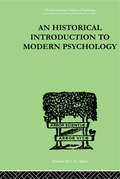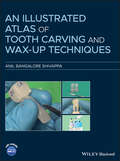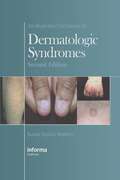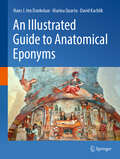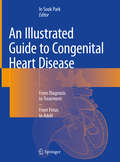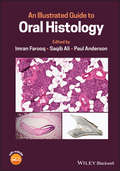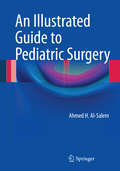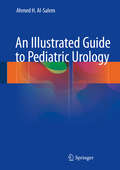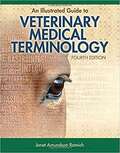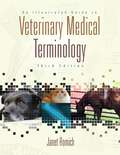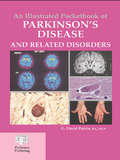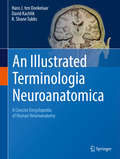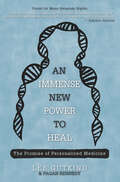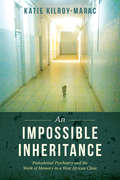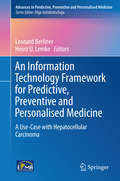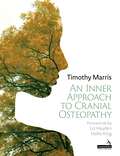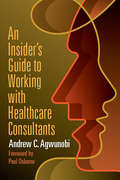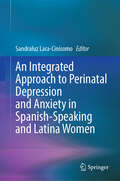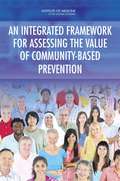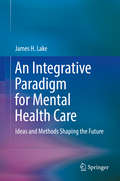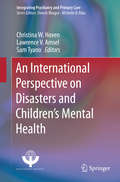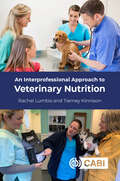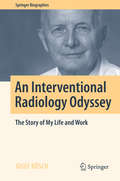- Table View
- List View
An Historical Introduction To Modern Psychology (International Library Of Psychology Ser.)
by Murphy, GardnerFirst published in 1999. Routledge is an imprint of Taylor & Francis, an informa company.
An Illustrated Atlas of Tooth Carving and Wax-Up Techniques
by Anil Bangalore ShivappaLearn the basics of dental morphology while improving your cognitive and psychomotor skills with one authoritative resource An Illustrated Atlas of Tooth Carving and Wax-Up Techniques combines important information on dental morphology, and tooth carving and wax-up techniques. This book provides those who wish to improve their cognitive and psychomotor skills with a comprehensive and authoritative resource essential to aesthetic and restorative procedures. Containing clear diagrams and detailed explanations on dental morphology and tooth carving, this book is invaluable for the improvement of manual dexterity in undergraduate and graduate students, particularly in the area of aesthetic procedures and restorative procedures. Contains information on the pre-carving preparation of wax blocks Provides a description of anatomical landmarks Offers a complete and stepwise guide to the carving and wax-up of each tooth Includes video resources, located on the companion website, to assist students in the procedure An Illustrated Atlas of Tooth Carving and Wax-Up Techniques is perfect for undergraduate and graduate students in dentistry who aim to improve their cognitive and psychomotor skills.
An Illustrated Dictionary of Dermatologic Syndromes
by Susan B. MalloryWritten by an internationally renowned researcher and teacher, this book provides a compendium of syndromes and dermatologic conditions. Completely revised and updated, the second edition includes genetic information, the genes and their loci, and the genetic linkage of certain syndromes that are now grouped with other diseases. The book retains the popular format of the first edition and includes color pictures of key syndromes from one of the major collections in the U.S. These features combine to make it an important book for office-based dermatologists who frequently see these problems in their practice and for dermatology residents who need this information to pass their boards. Describing some 716 syndromes in crisp detail with lavish color illustrations. A feature of special value is the list of carefully selected references quoted at the end of each entry to give the user ready access to definitive further reading on each syndrome. For residents and attending physicians alike, remembering and recognizing the variety of dermatologic syndromes that have been identified is a very difficult and time-consuming task. An Illustrated Dictionary of Dermatologic Syndromes provides a systematic and concise approach to the subject and is a valuable aid to both residents and attending physicians in dermatology and pediatrics. In his Foreword, Dr. Walter B. Shelley calls this, "a great book for browsing…a symphony of syndromes."
An Illustrated Guide to Anatomical Eponyms
by David Kachlík Hans J. Donkelaar Marina QuartuThis book provides a comprehensive overview of the anatomical eponyms in use in anatomy and in clinical disciplines. It includes brief descriptions of those to whom eponyms were given with personal data, their relevant publications and illustrations. For the illustrations, engravings, portraits or photographs are included as well as examples of the original illustrations or newer ones showing what is meant by a certain eponym. The book contains three Sections: Section I The Classical Anatomical Eponyms, in which the major classical eponyms on arteries, bands, bodies, bundles, canals, corpuscles, ducts, fasciae, fibres, folds, foramina, fossae, ganglia, glands, ligaments, membranes, muscles, nerves, nodes, nuclei, plexuses, spaces, triangles, tubercles, valves and veins are summarized. This Section clearly shows that in various countries, different eponyms are given for the same structure. Section II lists the anatomical eponyms together with some relevant histological, embryological and anthropological eponyms, from A-Z. In Section III, anatomical eponyms in use in Abdominal Surgery, Dentistry, Neurology, Obstetrics and Gynaecology, Oncology, Ophthalmology, Orthopaedics, Otology, Phlebology, and Radiology of the Digestive System are discussed. Sections II and III are both abundantly illustrated. The book is intended for advanced medical students, anatomists, and clinicians using anatomical eponyms in their daily practice. Unique to the book is the combination of descriptions of the anatomical eponyms with illustrations.
An Illustrated Guide to Congenital Heart Disease: From Diagnosis to Treatment – From Fetus to Adult
by In Sook ParkThis book combines an exceptional wealth of precise, exquisite schematic drawings and high-quality images with clear explanatory text in order to provide readers with a crisp and clear understanding of all aspects of congenital heart disease, from diagnosis to treatment and from the fetus to the adult. In format the book appears similar to a large collection of case reports covering all types of congenital heart disease, including complex lesions such as single ventricle and atrial isomerism. For each lesion, the illustrations are placed before the text so that the reader can gain a quick and general overview before going into more detail. The contents are as practical and concise as possible. The intention is that, despite its size, the book will serve as a handy reference for cardiologists, surgeons, intensivists, obstetricians specializing in fetal sonography, nurses, trainees, students, researchers, and even patients and their families. This is a “must-have” bedside reference in the cardiac ward, the ICU, and the fetal sonography room and will even be valuable in outpatient clinics.
An Illustrated Guide to Oral Histology
by Paul Anderson Saqib Ali Imran FarooqLearn more about the histological presentation of diseased and normal oral tissues with this high definition illustrated dental reference An Illustrated Guide to Oral Histology delivers a collection of high-definition histological and pathological images, presenting both diseased and normal oral tissues. The book provides over 200 high-magnification histomicrographs of oral tissues, as well as definitions and explanations of key identifying histological and pathological features of oral tissues. Readers will also benefit from explanations of the clinical significance of particular features, numerous images of ground sections, haemotoxylin- and eosin-stained sections, and electron images. It also includes core topics such as: An introduction to tooth development, including the bud, cap, early bell, and late bell stages A thorough exploration of enamel, dentin, cementum and dental pulp A discussion of the periodontal ligament, including alveolar crest fibers, horizontal, oblique, apical, and inter-radicular fibers, transseptal fibers, and gingival fibers A guide to alveolar bone, oral mucosa, and salivary glands Perfect for postgraduate dental students, An Illustrated Guide to Oral Histology will also be useful to undergraduate dental students, and those looking to improve their understanding of the microscopic structure of dental tissues and their pathologies.
An Illustrated Guide to Pediatric Surgery
by Ahmed H. Al-SalemWritten in a simple point by point style for ease of use, this volume covers all aspects of pediatric surgery with emphasis on important points for diagnosis and management. Each chapter covers a topic with emphasis on the most common conditions in neonatal and general pediatric surgery. The text is well illustrated with clinical, operative, radiological, and histopathological color figures and illustrations. The book also presents some of the rare conditions encountered in pediatric surgery, as well as common pediatric urology conditions. An Illustrated Guide to Pediatric Surgery is a useful reference to pediatric surgeons, specialists, fellows and residents, as well as general surgeons, pediatricians, neonatologists, medical students and interns interested in pediatric surgery.
An Illustrated Guide to Pediatric Urology
by Ahmed H. Al-SalemThis book is vital for physicians caring for young patients with urological conditions, as a quick reference book that is easy to read and well-illustrated. Pediatric urological conditions are fairly common, and infants and children are seen on daily basis with urological problems either in clinics or in hospitals. This book is useful to general surgeons, pediatricians, pediatric surgeons, fellows, residents, general physicians and family physicians, medical students and nurses. The Editor has gained experience in the diagnosis and management of various urological problems in infants and children, working in busy hospital over the last 25 years.
An Illustrated Guide to Veterinary Medical Terminology
by Janet Amundson RomichProviding the ultimate terminology reference for veterinary assistants and technicians, AN ILLUSTRATED GUIDE TO VETERINARY MEDICAL TERMINOLOGY, 4e provides an engaging, systematic approach to learning medical terms and understanding basic principles of veterinary medicine. This user-friendly textbook delivers a unique pedagogical presentation that makes it a comprehensive learning resource. Focusing on how medical terms are formed, analyzed, and defined, the text discusses anatomical landmarks, the positioning of animals, and the relationships between body parts. It also introduces terms used in the animal industry. Case studies illustrate how medical terminology is experienced in real-world practice, and an audio wordlist enables readers to hear the terms they are learning.
An Illustrated Guide to Veterinary Medical Terminology (3rd edition)
by Janet Amundson RomichA systematic approach to breaking down the parts of medical terms is used, allowing readers to grasp basic medical concepts and apply critical thinking skills when faced with new and unfamiliar medical terminology.
An Illustrated Pocketbook of Parkinson's Disease and Related Disorders
by G. David PerkinAn authoritative introduction to Parkinson's disease and its related disorders and syndromes, this book provides a concise overview of the disease and its diagnosis and management. The author presents samples of clinical, investigative (CT, MRI, and PET), and pathological images with succinct descriptive text of the disorders featured. He describes
An Illustrated Terminologia Neuroanatomica: A Concise Encyclopedia of Human Neuroanatomy
by R. Shane Tubbs Hans J. ten Donkelaar David KachlíkThis book is unique in that it provides the reader with the most up-to-date terminology used to describe the human nervous system (central and peripheral) and the related sensory organs, i.e., the Terminologia Neuroanatomica (TNA), the official terminology of the IFAA (International Federation of Associations of Anatomists). The book provides a succinct but detailed review of the neuroanatomical structures of the human body and will greatly benefit not only various specialists such as (neuro)anatomists, neurologists and neuroscientists, but also students taking neuroanatomy and neuroscience courses. The book offers a high yield, combined presentation of neuroanatomical illustrations and text and provides the reader a ‘one-stop source’ for studying the intricacies of the human nervous system and its sensory organs. It includes an alphabetical list of official English terms and synonyms with the official Latin terms and synonyms from the TNA. With regard to the entries, the name of the item in standardized English is provided, followed by synonyms and the official TNA Latin term, Latin synonyms and eponyms, a short description and in many cases one or more illustrations. To facilitate the use of illustrations, certain entries such as the gyri or sulci of the cerebral cortex are presented together with extensive cross-references. Terms that form part of a certain structure (such as the amygdaloid body, the thalamus and the hypothalamus) are listed under the respective structure. Segments and branches of arteries are discussed under the main artery, for example the A1–A5 segments under the anterior cerebral artery. Most nerves can be found following their origin from the brachial, cervical and lumbosacral plexuses. However, the major nerves of the limbs are discussed separately, as are the cranial nerves. Nuclei can be found by their English name or under Nuclei by their eponym.
An Immense New Power to Heal
by Lee Gutkind Pagan KennedyIs personalized medicine--what some scientists call genetic medicine--a pipe dream or a panacea? Francis Collins, current director of the National Institutes of Health and director of the Human Genome Project, considers this new era "the greatest revolution since Leonardo," while Nobel Laureate Leland Hartwell compares personalized medicine to a train that has not yet left the station--"a very slow train with a very long way to go . . . before we arrive at our destination."There is no denying that new technology, which has triggered an explosion of scientific information, is ushering in a revolution in medicine--for specialists, general practitioners and the public. Anyone can spit in a cup and, for a small fee, learn about his or her individual genetic make-up. But how useful is this information, really, to us or to our doctors? What's more, how much do we truly want to know--and have others know--about our possible destiny? There is more than we can imagine at stake.In An Immense New Power to Heal, authors Lee Gutkind and Pagan Kennedy delve into the personal side of personalized medicine and offer the physician's perspective and the patient's experience through intimate narratives and case studies. They also offer an intriguing background of the personalized medicine movement including the fascinating personalities of the key scientists involved as well as a glimpse into the in-fighting that accompanies any race for a scientific breakthrough. The result is a highly engaging, lively, and provocative discussion about this revolution in health care, and most importantly, what it really means for patients now and in the future.
An Impossible Inheritance: Postcolonial Psychiatry and the Work of Memory in a West African Clinic
by Katie Kilroy-MaracWeaving sound historical research with rich ethnographic insight, An Impossible Inheritance tells the story of the emergence, disavowal, and afterlife of a distinctive project in transcultural psychiatry initiated at the Fann Psychiatric Clinic in Dakar, Senegal during the 1960s and 1970s. Today’s clinic remains haunted by its past and Katie Kilroy-Marac brilliantly examines the complex forms of memory work undertaken by its affiliates over a sixty year period. Through stories such as that of the the ghost said to roam the clinic’s halls, the mysterious death of a young doctor sometimes attributed to witchcraft, and the spirit possession ceremonies that may have taken place in Fann’s courtyard, Kilroy-Marac argues that memory work is always an act of the imagination and a moral practice with unexpected temporal, affective, and political dimensions. By exploring how accounts about the Fann Psychiatric Clinic and its past speak to larger narratives of postcolonial and neoliberal transformation, An Impossible Inheritance examines the complex relationship between memory, history, and power within the institution and beyond.
An Indecent Obsession
by Colleen McCulloughTo the battle-broken soldiers in her care, nurse Honour Langtry is a precious, adored reminder of the world before war. Then Michael Wilson arrives under a cloud of mystery and shame to change everything.
An Information Technology Framework for Predictive, Preventive and Personalised Medicine: A Use-Case with Hepatocellular Carcinoma (Advances in Predictive, Preventive and Personalised Medicine #8)
by Leonard Berliner Heinz U. LemkeThis book explores how PPPM, clinical practice, and basic research could be best served by information technology (IT). A use-case was developed for hepatocellular carcinoma (HCC). The subject was approached with four interrelated tasks: (1) review of clinical practices relating to HCC; (2) propose an IT system relating to HCC, including clinical decision support and research needs; (3) determine how a clinical liver cancer center can contribute; and, (4) examine the enhancements and impact that the first three tasks will have on the management of HCC. An IT System for Personalized Medicine (ITS-PM) for HCC will provide the means to identify and determine the relative value of the wide number of variables, including clinical assessment of the patient -- functional status, liver function, degree of cirrhosis, and comorbidities; tumor biology, at a molecular, genetic and anatomic level; tumor burden and individual patient response; medical and operative treatments and their outcomes.
An Inner Approach to Cranial Osteopathy
by Timothy MarrisThis book is for the current Cranial Osteopathic practitioner. It looks into Cranial Osteopathy from a more profound 'inner' approach to help the practitioner to understand Cranial Osteopathy from a deeper and broader perspective. The book starts by taking the reader on an 'inner' journey of understanding more about themselves as the practitioner, discussing the 'osteopathic toolbox', and the need to be 'inner centred' when diagnosing and treating. It then looks at aspects of diagnosis - of tissue and fluid states - giving the reader several 'inner' considerations which they should apply when assessing a patient. The book then looks at the whole body and using an 'inner' approach to assess and treat each area. Each chapter gives an overview of the relevant anatomy and discusses the osteopathic relevance and new ways of working. Case studies/clinical experiences are described and 'hands on' exercises, which can be accessed via audio files, are given for the reader to practise. These exercises should be done 'at the treatment table' and will prepare the reader to use the approaches described with their patients. The audio leads the listener through a 'guided tour' of the anatomy and explains the exercise while they use their hands to feel what the author is describing.This guide will help Cranial Osteopathic practitioners enhance their skills, knowledge and understanding to a much-advanced level.
An Insider's Guide to Working with Healthcare Consultants (ACHE Management)
by Andrew AgwunobiHiring a consulting firm can be a daunting prospect. Do you really need consultants? If you do, how do you know you are getting the best value for your money? An Insider’s Guide to Working with Healthcare Consultants: How to Achieve Exceptional Results answers those questions.With his dual perspective as a hospital CEO and a healthcare consultant, author Andrew C. Agwunobi is uniquely qualified to help hospital leaders become masters of the successful consulting engagement. He explains: When—and whether—to hire consultantsHow to choose the right consultantsHow to negotiate the right priceHow to lead an engagement to the desired conclusionHow to sustain improvements This insider’s guide includes tips from 40 leading consultants to help clients establish and maintain mutually beneficial relationships. Real-world case studies illustrate common business problems and solutions, and a checklist at the end of each chapter emphasizes key considerations. Nearly every major project begins with a mission-critical decision: Hire outside professionals or depend on internal resources? Armed with this book’s insights, healthcare leaders can make that decision with confidence and avoid costly mistakes.
An Integrated Approach to Perinatal Depression and Anxiety in Spanish-Speaking and Latina Women
by Sandraluz Lara-CinisomoThis book makes a significant contribution to the literature by adopting an integrated perspective on perinatal depression and anxiety among Spanish-speaking and Latina women. These groups are often overlooked in research and face barriers to diagnosis and treatment. This groundbreaking book compiles essential and timely insights into the factors associated with perinatal depression and anxiety among Spanish-speaking and Latina women. It delves into crucial themes, such as migration-related experiences. Additionally, it explores policies in Latin America aimed at addressing maternal mental health needs. Furthermore, the book provides fundamental knowledge on tailoring culturally and linguistically appropriate interventions for perinatal depression and anxiety among Spanish-speaking and Latina women. Recognizing the significance of context, it offers perspectives on the effects of natural disasters and health crises on perinatal mental health and mother-infant bonding. The book advocates for the development of a research and mental health workforce attuned to the diverse needs of Spanish-speaking and Latina/Latinx perinatal women. It also discusses the value of biomarkers in perinatal depression research. In sum, this book brings together topic experts from across the globe to provide a more holistic approach to perinatal depression and anxiety. Key topics covered include: Anxiety and Worry During the Perinatal Period: Why They Cannot Be Ignored Protective Factors Against Depression and Anxiety Among Latinas and Spanish-Speaking Women Culturally Sensitive Interventions for Latinas and Spanish-Speaking Women Advancing Research in Perinatal Mental Health in Spanish-Speaking Latin American Women Developing a Culturally Responsive Mental Health Workforce for Spanish-speaking and Latina/Latinx Birthing People with Perinatal Depression and Anxiety An Integrated Approach to Perinatal Depression and Anxiety in Spanish-Speaking and Latina Women is pertinent reading for individuals interested in pursuing a degree and profession in perinatal mental health, clinicians working with Spanish-speaking and Latina/Latinx perinatal women, researchers interested in working with Spanish-speaking and Latina/Latinx perinatal women, and educators training individuals pursuing a degree and profession in perinatal mental health.
An Integrated Framework for Assessing the Value of Community-Based Prevention
by Institute of Medicine Board on Population Health and Public Health Practice Committee on Valuing Community-Based, Non-Clinical Prevention ProgramsDuring the past century the major causes of morbidity and mortality in the United States have shifted from those related to communicable diseases to those due to chronic diseases. Just as the major causes of morbidity and mortality have changed, so too has the understanding of health and what makes people healthy or ill. Research has documented the importance of the social determinants of health (for example, socioeconomic status and education) that affect health directly as well as through their impact on other health determinants such as risk factors. Targeting interventions toward the conditions associated with today's challenges to living a healthy life requires an increased emphasis on the factors that affect the current cause of morbidity and mortality, factors such as the social determinants of health. Many community-based prevention interventions target such conditions. Community-based prevention interventions offer three distinct strengths. First, because the intervention is implemented population-wide it is inclusive and not dependent on access to a health care system. Second, by directing strategies at an entire population an intervention can reach individuals at all levels of risk. And finally, some lifestyle and behavioral risk factors are shaped by conditions not under an individual's control. For example, encouraging an individual to eat healthy food when none is accessible undermines the potential for successful behavioral change. Community-based prevention interventions can be designed to affect environmental and social conditions that are out of the reach of clinical services. Four foundations - the California Endowment, the de Beaumont Foundation, the W.K. Kellogg Foundation, and the Robert Wood Johnson Foundation - asked the Institute of Medicine to convene an expert committee to develop a framework for assessing the value of community-based, non-clinical prevention policies and wellness strategies, especially those targeting the prevention of long-term, chronic diseases. The charge to the committee was to define community-based, non-clinical prevention policy and wellness strategies; define the value for community-based, non-clinical prevention policies and wellness strategies; and analyze current frameworks used to assess the value of community-based, non-clinical prevention policies and wellness strategies, including the methodologies and measures used and the short- and long-term impacts of such prevention policy and wellness strategies on health care spending and public health. An Integrated Framework for Assessing the Value of Community-Based Prevention summarizes the committee's findings.
An Integrative Approach to Treating Babies and Children: A Multidisciplinary Guide
by Michael Shea Franklyn Sills Ann Diamond Weinstein John Wilks Anita Hegerty David Haas Dr Carolyn Goh Graham Kennedy Matthew Appleton Professor Franz Ruppert Thomas HarmsWorking with babies and children is most successful when therapists have a complete understanding and overview of all appropriate treatment options, and the effects of early influences on child health and development. This book shows therapists how to consider these factors in order to work more effectively within their individual areas of expertise. Contributors from a wide range of disciplines explore the influence of pregnancy, birth and family dynamics on the physical and mental health of babies and children. They show how these factors relate to common complaints, such as excessive and different types of crying, chronic illnesses and poor immune systems, and behavioural and attachment issues, and how complementary approaches can be best applied to treat these issues. This book also offers helpful advice for working within multidisciplinary teams. Illustrated with case studies and including examples from current research, this book is a valuable resource for therapists from diverse disciplines.
An Integrative Paradigm for Mental Health Care: Ideas and Methods Shaping the Future
by James H. LakeThis crucial volume provides a concise overview of the conceptual foundations and clinical methods underlying the rapidly emerging subspecialty of integrative mental healthcare. It discusses methods for guiding practitioners to individualized integrative strategies that address unique symptoms and circumstances for each patient and includes practical clinical techniques for developing interventions addressed at wellness, prevention, and treatment. Included among the overview:Meeting the challenges of mental illness through integrative mental health care.Evolving paradigms and their impact on mental health careModels of consciousness: How they shape understandings of normal mental functioning and mental illnessFoundations of methodology in integrative mental health careTreatment planning in integrative mental health careThe future of mental health careA New Paradigm for Integrative Mental Healthcare is relevant and timely for the increasing numbers of patients seeking integrative and alternative care for depressed mood, anxiety, ADHD, bipolar disorder, schizophrenia, and other mental health problems such as fatigue and chronic pain. “Patients are crying out for a more integrative approach, and this exemplary book provides the template for achieving such a vision.” -Jerome Sarris, MHSc, PhD, ND“For most conventionally trained clinicians the challenge is not “does CAM work?” but “how do I integrate CAM into my clinical practice?” Lake’s comprehensive approach answers this central question, enabling the clinician to plan truly integrative and effective care for the mind and body.”-Leslie Korn, PhD, MPH
An International Perspective on Disasters and Children's Mental Health: An International Perspective (Integrating Psychiatry and Primary Care)
by Christina W. Hoven Lawrence V. Amsel Sam TyanoThis book provides a broad international perspective on the psychological trauma faced by children and adolescents exposed to major disasters, and on the local public health response to their needs. An outstanding quality of the book is that it draws upon the experience of local researchers, clinicians, and public mental health practitioners who dedicated themselves to these children in the wake of overwhelming events. The chapters address exemplary responses to a wide variety of trauma types, including severe weather, war, industrial catastrophes, earthquakes, and terrorism. Because disasters do not recognize geographic, economic, or political boundaries, the chapters have been selected to reflect the diverse global community’s attempt to respond to vulnerable children in the most challenging times. The book, thus, examines a diverse range of healthcare systems, cultural settings, mental health infrastructure, government policies, and the economic factors that have played an important role in responses to traumatic events. The ultimate goal of this book is to stimulate future international collaborations and interventions that will promote children’s mental health in the face of disaster.
An Interprofessional Approach to Veterinary Nutrition
by Tierney Kinnison Rachel LumbisIn veterinary practice, the interface between veterinarians, veterinary nurses or technicians, and paraprofessional team members is crucial. It influences patient care, incidence of medical errors, client satisfaction, success of the veterinary practice and revenue generation. Ensuring a coherent approach to the maintenance of animal health and wellbeing is of paramount importance, yet challenges such as interprofessional prejudice, misunderstanding of motivations, and a lack of recognition, respect, empowerment or trust, can prevent best practice. Nutrition is one of the most important considerations in the maintenance of health, and plays a critical role in disease management, patient recovery and hospital outcome; a reflection of its recognition as the fifth vital assessment. Owners are increasingly aware of the role of nutrition in optimising pet health, yet considerable misinformation can make this one of the most difficult aspects of pet ownership. Playing a central role as a source of expert information, veterinary healthcare teams must rise to the challenge of optimising pet nutrition. Effective interprofessional communication and collaboration is considered a key factor in the successful implementation of nutritional assessment, and a positive team environment founded on respect, trust and mutual support helps overcome challenges and provide the best outcome for both pets and their owners. This book provides evidence-based theory in an accessible and practical way to help veterinary healthcare teams implement interprofessional approaches to nutritional care and support.
An Interventional Radiology Odyssey: The Story of My Life and Work (Springer Biographies)
by Josef RöschIn this autobiography, Josef Rösch, aleading pioneer in interventional radiology from its inception to the present,documents his life and discusses important aspects of his work, focusingespecially on those procedures that he developed or improved and that were popularizedby his lectures and publications. In Prague, Dr. Rösch worked onsplenoportography and visceral angiography, while in the United States hedeveloped the transjugular intrahepatic portosystemic shunt (TIPS) and introducedembolization for treatment of GI bleeding and expandable metallic stenting ofobstructions of major veins and the esophagus. In addition, he contributed tothe improvement of coronary angiography and fallopian tube catheterization. Thebook also describes the author's role as the lead person in establishing theDotter Interventional Institute in 1990. The Institute was the firstfreestanding, independent interventional radiology unit to deal with education,research, and patient care. Dr. Rösch's organization of scientific meetings andhis early use of techniques for live internet broadcasting are described, andthe book concludes by summarizing the multiple honors and awards that he receivedin recognition of his achievements.
